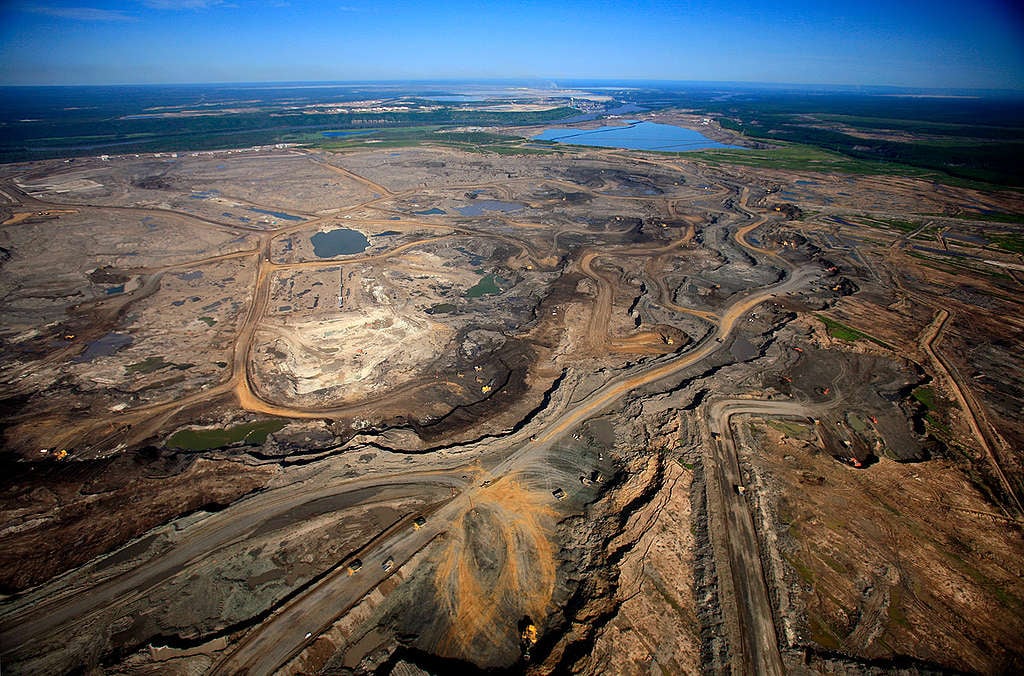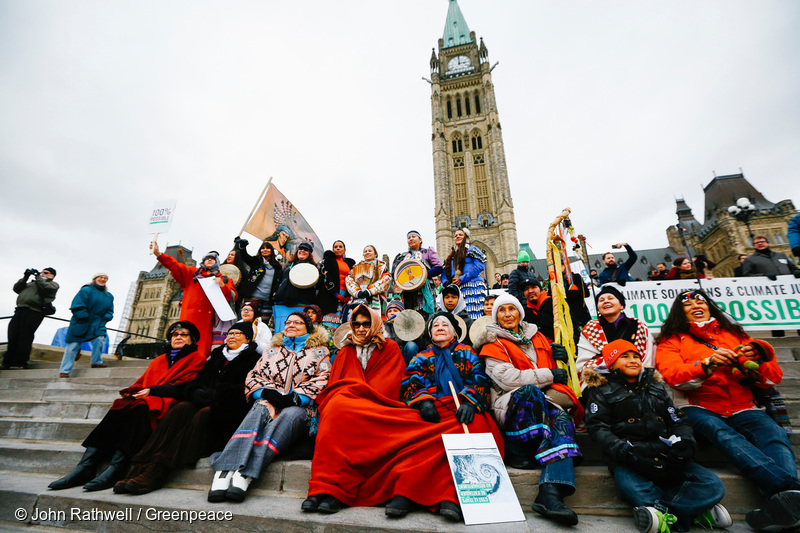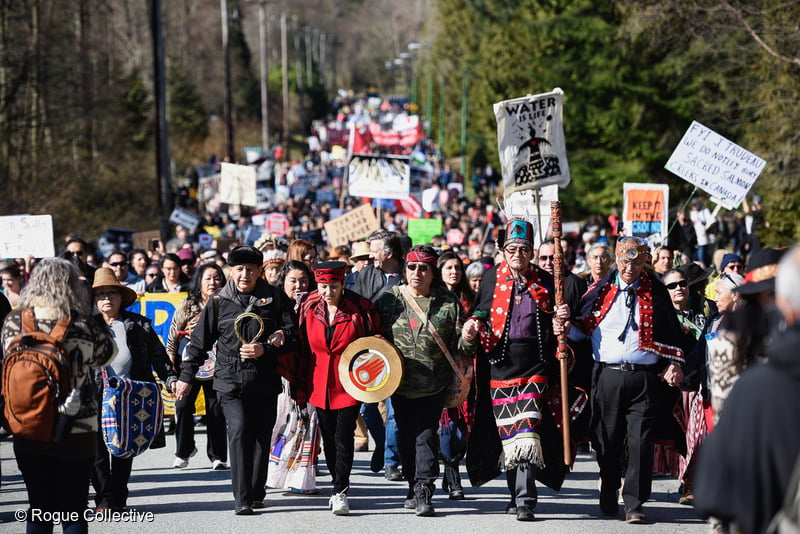If you could defuse one of the world’s biggest carbon bombs, wouldn’t you?

Each day, our window for saving the climate — and the billions of lives that depend on it — gets a little bit narrower. While people all around the world are taking action, oil companies are trying to light the fuse of one of the world’s biggest carbon bombs.
Deep in western Canada, on lands where Indigenous communities have lived since time immemorial, sit the Alberta tar sands. The tar sands are vast oil fields and mines in the Canadian province of Alberta.
Seen from the sky, the tar sands reach beyond the horizon and seem to go on forever, resembling a painful scar on the Earth of epic proportions. Nearby riverbeds are visible as water levels strain under industrial use. Chemical runoff pools collect in massive toxic lakes that stain the landscape. Lingering in the air above (and in the surrounding communities), there can be a sharp smell like burned tires, causing a searing feeling in the lungs.
Experiencing all this for the first time can be overwhelming and traumatic — even difficult to believe. It’s not what comes to mind when people from around the world imagine Canada’s crystal clear rivers and lakes, the evergreen forests teeming with life, or the breathtaking beauty of popular national parks little more than a stone’s throw from this environmental nightmare.
So what are the oil sands and how big are they?
The tar sands, sometimes called oil sands, are a massive site of oil extraction in Alberta. They cover an area larger than England and are one of the biggest industrial projects on the planet.
What is tar sands oil and why is it so bad for the environment?
The type of oil in the tar sands is called “bitumen”. It is extremely heavy (like tar) and difficult to extract. Getting it from deep in the ground to the surface can use up massive amounts of water — enough to rival what a small city may use on a daily basis. Even more water and energy is needed to refine it into anything resembling what goes into your gas tank. The amount of climate-polluting greenhouse gases emitted per barrel of tar sands oil can be 30% higher (throughout its life cycle) than conventional oil.
What is the impact of the tar sands on climate change and the boreal forest?
Canada’s oil and gas sector is the largest and fastest rising source of greenhouse gas emissions in Canada, accounting for 26% of the total. The tar sands are a key culprit. Between 1990 and 2018, tar sands production increased by 456%. The industry’s carbon footprint is greater than New Zealand and Kenya combined.
Nature advocates estimate that the industrial development and wildfires in the tar sands region have cleared or degraded nearly two million acres of boreal forest since the turn of the millennium. This puts vital habitat for birds, caribou and other animals at risk. It’s also a climate issue since the boreal forest is a vital carbon sink.
The world can’t afford to expand the Alberta tar sands, not if we want to preserve this planet for future generations. Current generations are already being impacted by the biodiversity crisis and climate change and its effects on sea level rise, drinking water, disease and extreme weather events.
How do the tar sands violate Indigenous rights, and how are communities fighting back?
Yes. Throughout the years, the tar sands have encroached on Indigenous Peoples’ traditional lands and contaminated the environment and wildlife these communities depend on for their culture and way of life. Tar sands chemicals have further been linked to higher rates of cancer in Indigenous communities and dangerous air pollution.
And the effects of the tar sands don’t stay in Canada. Globally, Indigenous communities and the Global South are on the frontline of climate impacts. In 2017, Indigenous leaders from the Pacific Islands came face-to-face with the tar sands, a culprit in the planetary warming driving rising sea levels, which in turn are having a devastating impact on their homes and families right now. Learn more about their emotional journey below.
Indigenous Peoples are also leading the resistance against tar sands projects that violate their rights. Roughly 150 Nations have signed a Treaty against Tar Sands Expansion. Groups like Indigenous Climate Action, the Braided Warriors, the Tiny House Warriors and others are resisting pipelines like the Trans Mountain Expansion and forging Indigenous-led solutions.
What are the key projects that would expand the tar sands?
The stakes are high in the tar sands — for the communities and for the world. But instead of slamming on the brakes on expanding operations, Canadian governments are helping industry by stepping on the gas.
Several major oil and gas pipelines, which would cross Indigenous lands without consent, have federal and provincial governments support. Among them are:
- Trans Mountain Expansion (TMX): Originally proposed by Kinder Morgan then bought by the Canadian government in 2018, this pipeline would run from Alberta to the Vancouver region, threatening drinking water and bringing increased oil tanker traffic that threaten endangered orca whales. Read more.
- Keystone XL: Supported by the Canadian government and cancelled by U.S. President Joe Biden, this TC Energy pipeline would run from Alberta to Nebraska, connecting with another pipeline to transport oil across sensitive aquifers vital for drinking and farming water before reaching the Gulf Coast of Texas. Read more about Indigenous opposition here in Canada and the impacts south of the colonial border.
- Line 3: Gas giant Enbridge wants to construct a tar sands pipeline from Alberta to Wisconsin, even though the company is responsible for one of the worst and most expensive inland oil spills in history. The pipeline would go through vital river waters as well as the wetlands and treaty territory of the Anishinaabe peoples. Read more about the fight against Line 3.
Many of these pipeline projects or the companies behind them are funded by private investors, big banks (like Royal Bank of Canada, CIBC and TD Bank), and even Canadian taxpayers in the case of TMX. Read more on why funding pipelines is financially risky.
How can I help stop tar sands pipelines and other expansion projects?
You can take the first step by joining our organization as well as supporting Indigenous-led struggles. Greenpeace activists are taking action in the streets, exercising our right to peaceful protest, signing petitions, meeting with our Members of Parliament and holding corporations accountable. Every day, more and more of us are standing up for climate justice and opposing industry’s attempts to expand oil and gas production. Join us in calling on Canada’s government to defuse one of the biggest carbon bombs on Earth.
This blog was updated in May 2021.




Discussion
What an incredible crock of propaganda. "Saving" What has Greenpeace ever saved ? Greenpeace and it's wrenches stuck in the cogs have only serve to raise the price of everything the civilized world has built. Your condescending words and obvious joy in making other peoples lives more difficult and expensive is selfish. your gratuitous use of children should embarrass you. The fact that it (doesn't) reveals your true character . with over 40,000 miles of fuel pipelines in the United States serving 300 million customers the impact of pipelines is almost entirely positive. Any problems caused by a pipeline just create more employment for the mechanics . The Kinder Morgan TransCanada pipeline will absolutely be built. The Keystone XL pipeline will be built. The North Dakota access pipeline is currently pumping fuel. Canadians by the thousands drive over our border every day to buy fuel at a much lower price in the US . Greenpeace is an organization of self congratulating hypocrites . all you hypocrites should continue to do your kayak protesting in your petroleum derivative kayaks. My friends and I will enjoy another good laugh .
Wonder
This dirty means of power is limited. Oil and gas are on their way out. It may not be right away because it takes time to transition and put other mean in place. OUR planet and the future of it and for our children are in jeopardy. Trudeau said in his 2019 campaign that he would educate and train the oil workers for the new form of energy that will be our future. He is just trying to milk it for whatever he can get out of it but, we the people are much wiser now and we won't put up with it. Greenpeace is doing a magnificent job at bringing these issues to the forefront.
In Prince Rupert they are warming the bitter man in the containers Is that unhealthy to put these fumes in the air ?
I am a simple person. I understand that fosstl fuel, oil, gas and its use is harmful for the environment and pipeline projects are funded by private investors to make more profits for themselves. Enough! What I want to know is how we can continue to live the "good life" without these forms of energy. If we discontinue fossil fuel, oil, gas, etc. etc. what will replace that dirty energy so we can continue to enjoy the lifestyle we are now enoying. I am all for clean energy. Talk more about what will replace that, NOW! How do we produce CLEAN evergy to use in transportation, in our homes, etc. etc.
How, knowing all this, can these people and corporations move ahead with their plans. Are they that blinded by their positions and money? I'm sure each and everyone of them would raise he(( if someone came on their lawn and let their dogs poop all over it. Yet look at what they are doing!!!
Greenpeace - It appears as though the information for this article is coming from sources >5 yrs old. Is it still accurate? Does it need to be updated? Looking at Google Maps/Satellite, I can't see the TarSands being anywhere near the size of England. Please update this article by overlaying a map of England so that we can see the 'scale'. Thanks
I Hate this why does this even have to exist its ruining the forests and urgh!!!!!!!!!!
I am being asked to work on the TMX pipeline as an archaeologist. I will outright refuse to work on tribal lands where indigenous people have not consented. What purpose would gathering information about a past lifeway serve if your killing those you are studing? I dont know if I can morally participate in this endevour at all. Is there any info you would like me to gather if I work for them? Should I just refuse? I do not support the pipeline in any way.
It's a sad story of greed and corruption. I guess we will reap what we sow, it's not funny and it's upsetting to hear the comments of those who really don't care about anything except their own wealth and freedom to do whatever they want regardless of the cost.
The effects of climate change are here to stay. We can live without the tar sands oil. We cannot live without clean air to breathe and clean water to drink. Tell Liberty Mutual to cancel Trans Mountain. There is no amount of money worth the destruction of all life on earth.
We can live without the tar sands oil. We cannot live without clean air to breathe and clean water to drink. Tell Liberty Mutual to cancel Trans Mountain. There is no amount of money worth the destruction of all life on earth.
the human race is astonishly ignorant. the canadian government that puts economics before human preservation is proof of that. it's the greedy rich and powerful that will ultimately end life as we used to enjoy it.
I Share The Concerne.Please Keep me Informed On The Tar Sands Issue.
Amazing information! Thank you